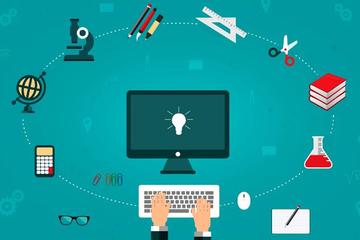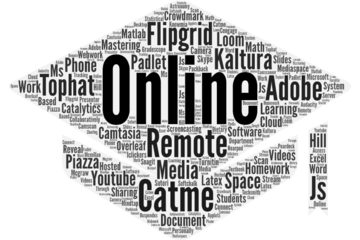Browse
Posted on: #iteachmsu

ASSESSING LEARNING
Search engine optimization
Introduction:
Search engine optimization (SEO)is the process of optimizing your online content so that a search engine likes to show it as a top result for searches of a certain keyword.
we can follow these seven steps to successful SEO:
Crawl accessibility so engines can read your website
Compelling content that answers the searcher’s query
Keyword optimized to attract searchers & engines
Great user experience including a fast load speed and compelling UX
Share-worthy content that earns links, citations, and amplification
Title, URL, & description to draw high CTR in the rankings
Snippet/schema markup to stand out in SERPs
Search engine optimization (SEO)is the process of optimizing your online content so that a search engine likes to show it as a top result for searches of a certain keyword.
we can follow these seven steps to successful SEO:
Crawl accessibility so engines can read your website
Compelling content that answers the searcher’s query
Keyword optimized to attract searchers & engines
Great user experience including a fast load speed and compelling UX
Share-worthy content that earns links, citations, and amplification
Title, URL, & description to draw high CTR in the rankings
Snippet/schema markup to stand out in SERPs
Authored by:
Rohit

Posted on: #iteachmsu


Search engine optimization
Introduction:
Search engine optimization (SEO)is the process o...
Search engine optimization (SEO)is the process o...
Authored by:
ASSESSING LEARNING
Thursday, Jan 28, 2021
Posted on: #iteachmsu

Test Technology Article
Test description
https://www.google.com/search?q=google&oq=google&aqs=chrome.0.0i131i433i457j0i433j69i59j0i131i433j69i60l4.1529j0j1&sourceid=chrome&ie=UTF-8
https://www.google.com/search?q=google&oq=google&aqs=chrome.0.0i131i433i457j0i433j69i59j0i131i433j69i60l4.1529j0j1&sourceid=chrome&ie=UTF-8
Authored by:
Kaileigh

Posted on: #iteachmsu


Test Technology Article
Test description
https://www.google.com/search?q=google&oq=goog...
https://www.google.com/search?q=google&oq=goog...
Authored by:
Monday, Jan 4, 2021
Posted on: #iteachmsu

ASSESSING LEARNING

Posted on: #iteachmsu


Test Article
Testing
Authored by:
ASSESSING LEARNING
Friday, Jan 1, 2021
Posted on: #iteachmsu

ASSESSING LEARNING
Response Accommodations
Educators should understand that students with disabilities often encounter barriers when they access the general education curriculum. The Every Student Succeeds Act (ESSA) and the Individuals with Disabilities Education Improvement Act (IDEA) require that educators provide appropriate accommodations to students with disabilities to address these barriers. Careful consideration of a student’s strengths and needs can help guide the identification and selection of an accommodation that is likely to benefit a student.
RE: https://microcredentials.digitalpromise.org/explore/response-accommodations
Response Accommodations
Response Accommodations
Educators should understand that students with disabilities often encounter barriers when they access the general education curriculum. The Every Student Succeeds Act (ESSA) and the Individuals with Disabilities Education Improvement Act (IDEA) require that educators provide appropriate accommodations to students with disabilities to address these barriers. Careful consideration of a student’s strengths and needs can help guide the identification and selection of an accommodation that is likely to benefit a student.
RE: https://microcredentials.digitalpromise.org/explore/response-accommodations
Posted by:
Scarlet Ethan Edien

Posted on: #iteachmsu

Response Accommodations
Educators should under...

Response Accommodations
Response Accommodations
Educators should under...
Posted by:
ASSESSING LEARNING
Thursday, Dec 31, 2020
Posted on: #iteachmsu

DISCIPLINARY CONTENT
Learning in a Digital Learning Environment
What are the 4Cs?
The 4Cs for 21st century learning are Creativity, Critical Thinking, Communication, and Collaboration. They are part of the framework for 21st Century Learning and are designed to support student learning in today’s world and are skills they can use in college and career.
What is communication (and what isn’t it)?
The P21 framework emphasizes effective use of oral, written, and nonverbal communication skills for multiple purposes (e.g., to inform, instruct, motivate, persuade, and share ideas). It also focuses on effective listening, using technology to communicate, and being able to evaluate the effectiveness of communication efforts—all within diverse contexts (adapted from P21). Note that working in partners is a great way to collaborate or build shared understanding but a critical part of communication is sharing with an authentic audience.
The 4Cs for 21st century learning are Creativity, Critical Thinking, Communication, and Collaboration. They are part of the framework for 21st Century Learning and are designed to support student learning in today’s world and are skills they can use in college and career.
What is communication (and what isn’t it)?
The P21 framework emphasizes effective use of oral, written, and nonverbal communication skills for multiple purposes (e.g., to inform, instruct, motivate, persuade, and share ideas). It also focuses on effective listening, using technology to communicate, and being able to evaluate the effectiveness of communication efforts—all within diverse contexts (adapted from P21). Note that working in partners is a great way to collaborate or build shared understanding but a critical part of communication is sharing with an authentic audience.
Posted by:
Rohit 936 shinde

Posted on: #iteachmsu


Learning in a Digital Learning Environment
What are the 4Cs?
The 4Cs for 21st century learning are Creativity,...
The 4Cs for 21st century learning are Creativity,...
Posted by:
DISCIPLINARY CONTENT
Thursday, Dec 31, 2020
Posted on: #iteachmsu

NAVIGATING CONTEXT
Creativity to Support Student Learning in a Digital Learning Environment
Method Components
What are the 4Cs?
The 4Cs for 21st century learning are Creativity, Critical Thinking, Communication, and Collaboration. They are part of the framework for 21st Century Learning and are designed to support student learning in today’s world and are skills they can use in college and career.
What is creativity (and what is it not)?
Stein (1953) defined creativity as “a novel work that is accepted as tenable or useful or satisfying by a group in some point in time” (p. 311). While many other definitions have emerged since 1953, many reiterate the idea of it being “novel” and “useful.” In the classroom, this means giving students freedom to create something new (novel) to address a problem or a need (useful). Construction of something new or innovative is a key component of creativity - creativity does not mean letting students color or copy an existing model, rather it means letting students create something new that can apply to a given, often teacher-created, context.
Example strategies that use technology to support creativity in the classroom:
Digital Storytelling:
Storybird: Storybird gathers images and invites students to turn those images into original stories.
Google docs are a simple tool that can allow your students to put their ideas to paper in an easy to share format.
Story builder
My Simple Show
Powtoon
Developing and Building Prototypes:
Google drawing or Tinkercad are great resources for designing digital prototypes
If you’re lucky enough to have access to a 3D printer see if your students can print their designs. If not, have them use the digital prototypes to mock up their own prototypes using other materials.
Appsmashing
(see https://www.smore.com/9g1x-elementary-ipads)
App smashing occurs when learners use the functionality from more than one tool to build something with greater functionality. App smashing requires more planning, experimentation and it can foster creativity.
For more ideas and examples, see the resources below.
Supporting Rationale and Research
Beghetto, R. A. (2013). Killing ideas softly? The promises and perils of creativity in the classroom. Charlotte, NC: Information Age Press.
Kaufman, J. C., & Beghetto, R. A. (2009). Beyond big and little: The Four C Model of Creativity. Review of General Psychology, 13, 1-2. doi:10.1037/a0013688
Resources
What We Know About Creativity (P21, Part of the 4Cs Research Series)https://www.scribd.com/document/360194838/p21-4cs-research-brief-series-creativityThis research brief provides an overview of creativity, the research on it, and some ideas for teachers to use for implementation in their classrooms.
Creativity in the Digital Classroom (21st Century Ed Tech)https://21centuryedtech.wordpress.com/2013/01/14/part-1-creativity-in-the-digital-classroom-over-40-resources-are-they-in-your-school/This blog lists 40 resources and tools you can use to support students’ creativity in your digital classroom. This is the first of a four part series so explore other posts for additional ideas.
Digital Storytelling Activitieshttps://sites.google.com/site/richardbyrnepdsite/digital-storytelling/digital-storytelling-challenge-activitiesRichard Byrne created this Google Site full of resources for educators interested in digital storytelling. There are a variety of types of digital storytelling activities, each with a beginner, intermediate, and advanced version based on your comfort with technology.
Introduction to the 4Cs (Common Sense Media)https://www.commonsense.org/videos/introduction-to-the-4-csThis brief video provides an easy to understand overview of the 4Cs model.
What are the 4Cs?
The 4Cs for 21st century learning are Creativity, Critical Thinking, Communication, and Collaboration. They are part of the framework for 21st Century Learning and are designed to support student learning in today’s world and are skills they can use in college and career.
What is creativity (and what is it not)?
Stein (1953) defined creativity as “a novel work that is accepted as tenable or useful or satisfying by a group in some point in time” (p. 311). While many other definitions have emerged since 1953, many reiterate the idea of it being “novel” and “useful.” In the classroom, this means giving students freedom to create something new (novel) to address a problem or a need (useful). Construction of something new or innovative is a key component of creativity - creativity does not mean letting students color or copy an existing model, rather it means letting students create something new that can apply to a given, often teacher-created, context.
Example strategies that use technology to support creativity in the classroom:
Digital Storytelling:
Storybird: Storybird gathers images and invites students to turn those images into original stories.
Google docs are a simple tool that can allow your students to put their ideas to paper in an easy to share format.
Story builder
My Simple Show
Powtoon
Developing and Building Prototypes:
Google drawing or Tinkercad are great resources for designing digital prototypes
If you’re lucky enough to have access to a 3D printer see if your students can print their designs. If not, have them use the digital prototypes to mock up their own prototypes using other materials.
Appsmashing
(see https://www.smore.com/9g1x-elementary-ipads)
App smashing occurs when learners use the functionality from more than one tool to build something with greater functionality. App smashing requires more planning, experimentation and it can foster creativity.
For more ideas and examples, see the resources below.
Supporting Rationale and Research
Beghetto, R. A. (2013). Killing ideas softly? The promises and perils of creativity in the classroom. Charlotte, NC: Information Age Press.
Kaufman, J. C., & Beghetto, R. A. (2009). Beyond big and little: The Four C Model of Creativity. Review of General Psychology, 13, 1-2. doi:10.1037/a0013688
Resources
What We Know About Creativity (P21, Part of the 4Cs Research Series)https://www.scribd.com/document/360194838/p21-4cs-research-brief-series-creativityThis research brief provides an overview of creativity, the research on it, and some ideas for teachers to use for implementation in their classrooms.
Creativity in the Digital Classroom (21st Century Ed Tech)https://21centuryedtech.wordpress.com/2013/01/14/part-1-creativity-in-the-digital-classroom-over-40-resources-are-they-in-your-school/This blog lists 40 resources and tools you can use to support students’ creativity in your digital classroom. This is the first of a four part series so explore other posts for additional ideas.
Digital Storytelling Activitieshttps://sites.google.com/site/richardbyrnepdsite/digital-storytelling/digital-storytelling-challenge-activitiesRichard Byrne created this Google Site full of resources for educators interested in digital storytelling. There are a variety of types of digital storytelling activities, each with a beginner, intermediate, and advanced version based on your comfort with technology.
Introduction to the 4Cs (Common Sense Media)https://www.commonsense.org/videos/introduction-to-the-4-csThis brief video provides an easy to understand overview of the 4Cs model.
Posted by:
Rohit 936 shinde

Posted on: #iteachmsu


Creativity to Support Student Learning in a Digital Learning Environment
Method Components
What are the 4Cs?
The 4Cs for 21st century learni...
What are the 4Cs?
The 4Cs for 21st century learni...
Posted by:
NAVIGATING CONTEXT
Thursday, Dec 31, 2020
Posted on: #iteachmsu

Communication to Support Student Learning in a Digital Learning Environment
Educator provides evidence of their understanding of communication and outlines and provides evidence of a lesson that uses technology to support students’ use of communication in learning.
Method Components
What are the 4Cs?
The 4Cs for 21st century learning are Creativity, Critical Thinking, Communication, and Collaboration. They are part of the framework for 21st Century Learning and are designed to support student learning in today’s world and are skills they can use in college and career.
What is communication (and what isn’t it)?
The P21 framework emphasizes effective use of oral, written, and nonverbal communication skills for multiple purposes (e.g., to inform, instruct, motivate, persuade, and share ideas). It also focuses on effective listening, using technology to communicate, and being able to evaluate the effectiveness of communication efforts—all within diverse contexts (adapted from P21). Note that working in partners is a great way to collaborate or build shared understanding but a critical part of communication is sharing with an authentic audience.
Example strategies that use technology to support communication in the classroom:
Host a TED-style conference or showcases for your students to present original ideas on a topic of interest to them to an authentic, external audience. Record and post the videos to a youtube stream.
Provide opportunities to listen and ask questions through back channel tools like Today’s Meet or even Twitter.
Have your students publish their work through blogs, by creating websites, and by building other online resources that are shared with authentic audiences.
For other ideas see the resources below.
Method Components
What are the 4Cs?
The 4Cs for 21st century learning are Creativity, Critical Thinking, Communication, and Collaboration. They are part of the framework for 21st Century Learning and are designed to support student learning in today’s world and are skills they can use in college and career.
What is communication (and what isn’t it)?
The P21 framework emphasizes effective use of oral, written, and nonverbal communication skills for multiple purposes (e.g., to inform, instruct, motivate, persuade, and share ideas). It also focuses on effective listening, using technology to communicate, and being able to evaluate the effectiveness of communication efforts—all within diverse contexts (adapted from P21). Note that working in partners is a great way to collaborate or build shared understanding but a critical part of communication is sharing with an authentic audience.
Example strategies that use technology to support communication in the classroom:
Host a TED-style conference or showcases for your students to present original ideas on a topic of interest to them to an authentic, external audience. Record and post the videos to a youtube stream.
Provide opportunities to listen and ask questions through back channel tools like Today’s Meet or even Twitter.
Have your students publish their work through blogs, by creating websites, and by building other online resources that are shared with authentic audiences.
For other ideas see the resources below.
Authored by:
NC sate

Posted on: #iteachmsu

ASSESSING LEARNING
Data Science, Deep Learning, and Artificial Intelligence
Artificial Intelligence
The term “AI” is used so often nowadays that we have a basic understanding of what it means: a computer’s ability to perform tasks such as visual perception, speech recognition, decision-making, and language translation. AI has progressed rapidly over the last few years, but it is still nowhere near matching the vast dimensions of human intelligence. Humans make quick use of all the data around them and can use what they have stored in their minds to make decisions. However, AI does not yet boast such abilities; instead, it is using huge chunks of data to clear its objectives. This ultimately means that AI might require huge chunks of data for doing something as simple as editing text.
Data Science
Data science is much more than just simple machine learning. Data here may not have been obtained through a machine, and it may not even be for learning purposes. Put, data science tends to cover the whole spectrum of data processing as we know it. Data science is not just related to the statistical aspect of the process, but it feeds the process and derives benefits from it through data engineering. Data engineers and data scientists have a huge role to play in propelling AI forward.
Deep Learning
Deep learning is machine learning’s most powerful technique for making the future happen. Much like the neurons in our brains, deep learning is the connection or the powerhouse present between data science and AI. Both machine learning and its subtype, deep learning, incorporate the process of learning from the data over time. While it is not the only thing connecting the two, deep learning is a type of machine learning that works best to strengthen the process of AI and data science. Deep learning can be defined as a machine learning technique that endeavors to teach computer systems things that come naturally to humans. For example, we can naturally interpret what a stop sign on the road means, but for a machine to locate this sign and interpret it, it needs a lot of learning and implementation.
The term “AI” is used so often nowadays that we have a basic understanding of what it means: a computer’s ability to perform tasks such as visual perception, speech recognition, decision-making, and language translation. AI has progressed rapidly over the last few years, but it is still nowhere near matching the vast dimensions of human intelligence. Humans make quick use of all the data around them and can use what they have stored in their minds to make decisions. However, AI does not yet boast such abilities; instead, it is using huge chunks of data to clear its objectives. This ultimately means that AI might require huge chunks of data for doing something as simple as editing text.
Data Science
Data science is much more than just simple machine learning. Data here may not have been obtained through a machine, and it may not even be for learning purposes. Put, data science tends to cover the whole spectrum of data processing as we know it. Data science is not just related to the statistical aspect of the process, but it feeds the process and derives benefits from it through data engineering. Data engineers and data scientists have a huge role to play in propelling AI forward.
Deep Learning
Deep learning is machine learning’s most powerful technique for making the future happen. Much like the neurons in our brains, deep learning is the connection or the powerhouse present between data science and AI. Both machine learning and its subtype, deep learning, incorporate the process of learning from the data over time. While it is not the only thing connecting the two, deep learning is a type of machine learning that works best to strengthen the process of AI and data science. Deep learning can be defined as a machine learning technique that endeavors to teach computer systems things that come naturally to humans. For example, we can naturally interpret what a stop sign on the road means, but for a machine to locate this sign and interpret it, it needs a lot of learning and implementation.
Posted by:
Rohit 936 shinde

Posted on: #iteachmsu


Data Science, Deep Learning, and Artificial Intelligence
Artificial Intelligence
The term “AI” is used so often nowadays tha...
The term “AI” is used so often nowadays tha...
Posted by:
ASSESSING LEARNING
Thursday, Dec 31, 2020




